Victoria Bushfire 2009: Strategies for Disaster Recovery and Response
VerifiedAdded on 2019/10/31
|13
|3308
|161
Report
AI Summary
This report, assuming the role of an emergency manager, provides an in-depth analysis of the 2009 Victoria bushfire, also known as Black Saturday, focusing on effective disaster recovery and response strategies. It examines the environmental conditions and factors that contributed to the bushfire, the impact on the community, and the subsequent recovery efforts. The report outlines key principles for managing the recovery phase, including understanding the context, community-led approaches, recognizing complexity, ensuring coordination, and employing effective communication. Furthermore, it details strategies such as fuel management, landscape fuel management, and fire operations planning, along with strategies for fire prevention. The effectiveness of the recovery phase management is evaluated based on its focus on management and governance initiatives, with suggestions for improvement. This report aims to provide a comprehensive guide for understanding and managing bushfire recovery, emphasizing the importance of community involvement and effective strategies.

Running Head: DISASTER RECOVERY AND RESPONSE
A Brief on Victoria Bushfire 2009 and Management of Recovery Phase
Name
Institution
A Brief on Victoria Bushfire 2009 and Management of Recovery Phase
Name
Institution
Paraphrase This Document
Need a fresh take? Get an instant paraphrase of this document with our AI Paraphraser

DISASTER RECOVERY AND RESPONSE 2
Summary
This paper is focused on the effective strategies that should be adopted in the
process of disaster response recovery. With the assumption of the emergency manager position,
the paper evaluates the 2009 Victoria bushfire as a case study while evaluating and outlining the
strategies and principles that can be adapted to effectively guidance and managementof the
disaster recovery process for the affected individuals in the Victoria 2009 bush fire. The report
thus analyzes different principles and strategies that when adopted will be efficient not only in
fire incidences but even other emergency issues as well.
Introduction
In our daily life, the world often faces great emergency situations which bear significant
impact on individuals as well as the society at large. One of the major emergency situations
which face a nation is the incident of a bushfire. Therefore, there is need to develop appropriate
management guides to help in the recovery phase of the affected regions as well as the affected
families. One of the major known bushfires is the Victoria bushfire that occurred on 2009 in the
Australia (Choo&Nadarajah, 2014). It is commonly referred to as the Black Saturday fires in
which historically these were the most devastating bush fires experienced in Australia. The tragic
event was precedent a number of factors which are believed to have resulted in the fires. The
Victoria state during this period this period was experiencing the worst weather conditions. The
state was experiencing extreme heat conditions, high winds, and low humidity as well as a severe
drought.
Purpose of the study
Summary
This paper is focused on the effective strategies that should be adopted in the
process of disaster response recovery. With the assumption of the emergency manager position,
the paper evaluates the 2009 Victoria bushfire as a case study while evaluating and outlining the
strategies and principles that can be adapted to effectively guidance and managementof the
disaster recovery process for the affected individuals in the Victoria 2009 bush fire. The report
thus analyzes different principles and strategies that when adopted will be efficient not only in
fire incidences but even other emergency issues as well.
Introduction
In our daily life, the world often faces great emergency situations which bear significant
impact on individuals as well as the society at large. One of the major emergency situations
which face a nation is the incident of a bushfire. Therefore, there is need to develop appropriate
management guides to help in the recovery phase of the affected regions as well as the affected
families. One of the major known bushfires is the Victoria bushfire that occurred on 2009 in the
Australia (Choo&Nadarajah, 2014). It is commonly referred to as the Black Saturday fires in
which historically these were the most devastating bush fires experienced in Australia. The tragic
event was precedent a number of factors which are believed to have resulted in the fires. The
Victoria state during this period this period was experiencing the worst weather conditions. The
state was experiencing extreme heat conditions, high winds, and low humidity as well as a severe
drought.
Purpose of the study

DISASTER RECOVERY AND RESPONSE 3
The main aim of the study is to evaluate and outline the strategies and principles that can
be adopted to effectively guide and manage the recovery process for the affected individuals in
the Victoria 2009 bush fire. The report gives an overview of the issue before, during, as well as
after the bushfire occurrence. The report then advises on the proper guidelines that can be
adopted to ensure a proper recovery management for fast and efficient recovery phase
management.
Overview of the Victorian community
Victoria community before the occurrence of the bushfire was a diverse community
consisting of various types of wildlife. The community had six special nature impacted sections
including Yarra Ranges National Park, Kinglake National Park, Cathedral Range, Lady Talbot
Drive, Wilsons Prom, and Keppel Falls. The forest also acted as a water catchment point. The
community had a big population of friendly people living together in harmony but later turned to
be a community of mourning for the lost lives (Whittaker, Eriksen, & Haynes. 2016).
Background of the Issue
The Black Saturday bushfire in Victoria occurred on February 7th, 2009. It has since
remained in the record as one of the most destructive and horrific natural disasters that have ever
witnessed in Australia. As reported by the Australian Fire Authority report, 592 bush and grass
fires, as well as 263 structure fires, were reported in the black Saturday (Bryant et al. 2014). On
that same day, the major fires in terms of significant damage or loss were at Kilmore East,
Churchill, Delburn, Narre Warren, Redesdale, Horsham, Bendigo, and Bunyip among others
(Whittaker, Eriksen, & Haynes. 2016). In general, the fire destroyed and severely y damaged
over 3400 homes in Victoria and burnt about 430,000 hectares of land. More tragically, 173
The main aim of the study is to evaluate and outline the strategies and principles that can
be adopted to effectively guide and manage the recovery process for the affected individuals in
the Victoria 2009 bush fire. The report gives an overview of the issue before, during, as well as
after the bushfire occurrence. The report then advises on the proper guidelines that can be
adopted to ensure a proper recovery management for fast and efficient recovery phase
management.
Overview of the Victorian community
Victoria community before the occurrence of the bushfire was a diverse community
consisting of various types of wildlife. The community had six special nature impacted sections
including Yarra Ranges National Park, Kinglake National Park, Cathedral Range, Lady Talbot
Drive, Wilsons Prom, and Keppel Falls. The forest also acted as a water catchment point. The
community had a big population of friendly people living together in harmony but later turned to
be a community of mourning for the lost lives (Whittaker, Eriksen, & Haynes. 2016).
Background of the Issue
The Black Saturday bushfire in Victoria occurred on February 7th, 2009. It has since
remained in the record as one of the most destructive and horrific natural disasters that have ever
witnessed in Australia. As reported by the Australian Fire Authority report, 592 bush and grass
fires, as well as 263 structure fires, were reported in the black Saturday (Bryant et al. 2014). On
that same day, the major fires in terms of significant damage or loss were at Kilmore East,
Churchill, Delburn, Narre Warren, Redesdale, Horsham, Bendigo, and Bunyip among others
(Whittaker, Eriksen, & Haynes. 2016). In general, the fire destroyed and severely y damaged
over 3400 homes in Victoria and burnt about 430,000 hectares of land. More tragically, 173
⊘ This is a preview!⊘
Do you want full access?
Subscribe today to unlock all pages.

Trusted by 1+ million students worldwide
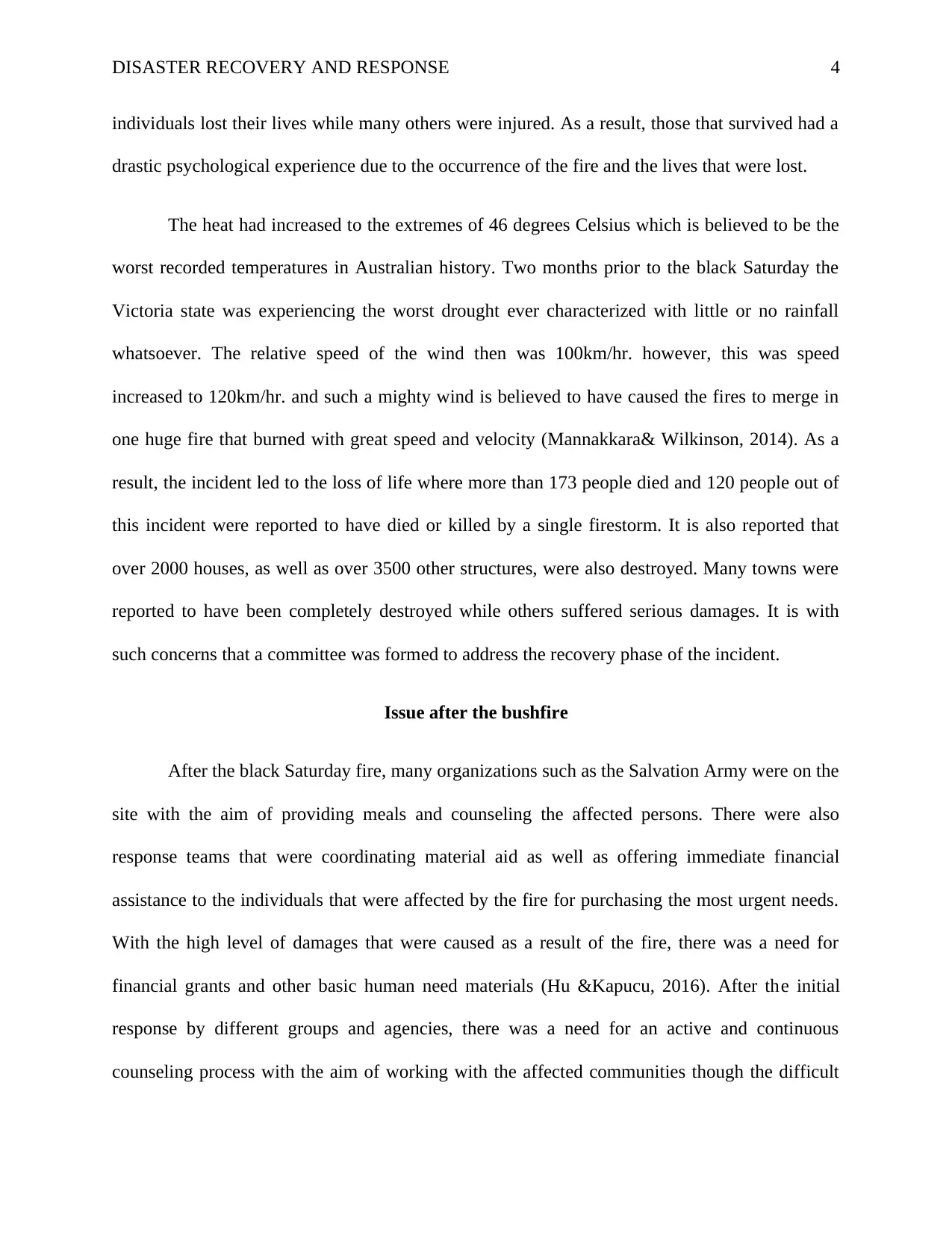
DISASTER RECOVERY AND RESPONSE 4
individuals lost their lives while many others were injured. As a result, those that survived had a
drastic psychological experience due to the occurrence of the fire and the lives that were lost.
The heat had increased to the extremes of 46 degrees Celsius which is believed to be the
worst recorded temperatures in Australian history. Two months prior to the black Saturday the
Victoria state was experiencing the worst drought ever characterized with little or no rainfall
whatsoever. The relative speed of the wind then was 100km/hr. however, this was speed
increased to 120km/hr. and such a mighty wind is believed to have caused the fires to merge in
one huge fire that burned with great speed and velocity (Mannakkara& Wilkinson, 2014). As a
result, the incident led to the loss of life where more than 173 people died and 120 people out of
this incident were reported to have died or killed by a single firestorm. It is also reported that
over 2000 houses, as well as over 3500 other structures, were also destroyed. Many towns were
reported to have been completely destroyed while others suffered serious damages. It is with
such concerns that a committee was formed to address the recovery phase of the incident.
Issue after the bushfire
After the black Saturday fire, many organizations such as the Salvation Army were on the
site with the aim of providing meals and counseling the affected persons. There were also
response teams that were coordinating material aid as well as offering immediate financial
assistance to the individuals that were affected by the fire for purchasing the most urgent needs.
With the high level of damages that were caused as a result of the fire, there was a need for
financial grants and other basic human need materials (Hu &Kapucu, 2016). After the initial
response by different groups and agencies, there was a need for an active and continuous
counseling process with the aim of working with the affected communities though the difficult
individuals lost their lives while many others were injured. As a result, those that survived had a
drastic psychological experience due to the occurrence of the fire and the lives that were lost.
The heat had increased to the extremes of 46 degrees Celsius which is believed to be the
worst recorded temperatures in Australian history. Two months prior to the black Saturday the
Victoria state was experiencing the worst drought ever characterized with little or no rainfall
whatsoever. The relative speed of the wind then was 100km/hr. however, this was speed
increased to 120km/hr. and such a mighty wind is believed to have caused the fires to merge in
one huge fire that burned with great speed and velocity (Mannakkara& Wilkinson, 2014). As a
result, the incident led to the loss of life where more than 173 people died and 120 people out of
this incident were reported to have died or killed by a single firestorm. It is also reported that
over 2000 houses, as well as over 3500 other structures, were also destroyed. Many towns were
reported to have been completely destroyed while others suffered serious damages. It is with
such concerns that a committee was formed to address the recovery phase of the incident.
Issue after the bushfire
After the black Saturday fire, many organizations such as the Salvation Army were on the
site with the aim of providing meals and counseling the affected persons. There were also
response teams that were coordinating material aid as well as offering immediate financial
assistance to the individuals that were affected by the fire for purchasing the most urgent needs.
With the high level of damages that were caused as a result of the fire, there was a need for
financial grants and other basic human need materials (Hu &Kapucu, 2016). After the initial
response by different groups and agencies, there was a need for an active and continuous
counseling process with the aim of working with the affected communities though the difficult
Paraphrase This Document
Need a fresh take? Get an instant paraphrase of this document with our AI Paraphraser

DISASTER RECOVERY AND RESPONSE 5
recovery process. The affected population required financial, emotional, and material needs as
well as building events, specialist supports, and activities that would help them through the
process.
Key principles in management of the recovery phase
The management of the fire recovery phase can be achieved if the following principles as
identified by the Emergency Management Committee established are puts into consideration.
The principles emphasize on a shared disclosure to ensure effective communication as well as
making sound decisions that enable the communities to cope and adjust to recovery. The
principles include;
Understanding the context;the recovery phase can be effective if only the context is
understood by the management committee. This principle provides that only the disaster affected
individuals, communities as well as the organizations involved are in a position to understand
their own needs than agencies from any external experts or organizations. Therefore the agenices
involved in recovery process should involve, interact and communicate with the community as
well as the affected groups (Clode& Elgar, 2014).
Easing community lead approach; this approach ensures that the community is involved
in the recovery phase of disaster. The principle is guided by the ideology that communities are in
better position to understand what works best for them and also the fact that future effectiveness
in disaster management will be as a result of capacity building in the society. If a community
lead approach is done then the community will be in a position to manage such occurrences in
future (Reid &Beilin, 2014).
recovery process. The affected population required financial, emotional, and material needs as
well as building events, specialist supports, and activities that would help them through the
process.
Key principles in management of the recovery phase
The management of the fire recovery phase can be achieved if the following principles as
identified by the Emergency Management Committee established are puts into consideration.
The principles emphasize on a shared disclosure to ensure effective communication as well as
making sound decisions that enable the communities to cope and adjust to recovery. The
principles include;
Understanding the context;the recovery phase can be effective if only the context is
understood by the management committee. This principle provides that only the disaster affected
individuals, communities as well as the organizations involved are in a position to understand
their own needs than agencies from any external experts or organizations. Therefore the agenices
involved in recovery process should involve, interact and communicate with the community as
well as the affected groups (Clode& Elgar, 2014).
Easing community lead approach; this approach ensures that the community is involved
in the recovery phase of disaster. The principle is guided by the ideology that communities are in
better position to understand what works best for them and also the fact that future effectiveness
in disaster management will be as a result of capacity building in the society. If a community
lead approach is done then the community will be in a position to manage such occurrences in
future (Reid &Beilin, 2014).

DISASTER RECOVERY AND RESPONSE 6
Recognizing complexity; the recovery process is always complex and involves an
extensive variety of individuals, groups and organizations. Effective recovery phase will
therefore call for understanding the complexity of the process by all stakeholders and ensuring
that everything works for the interest of all the involved groups (Whittaker et al. 2016). By doing
so, it will be easy to achieve the goals of disaster recovery.
Ensuring coordination of all activities;due to the complexity of the process of recovery, it
is important that all activities are coordinated in line with the goals of disaster management. The
efforts from different agencies and stakeholders including the disaster affected individuals and
the community as well as the external experts should be coordinated and ensure that they
collectively work for the greater good of all (Curnin et al. 2015).
Employing effective communication; like any other project, the success of disaster
management and recovery phase is influenced by the communication process. Since the process
involves many stakeholders who may be having different views and opinions as well as
approaches to provide solutions to remedy the situation, it is important for consultations,
discussions and collective decision making to be made through communication (Howes et al.
2015). It is therefore that effective communication strategies are employed and utilized by all the
stakeholders in the management of bushfires.
Key strategies for effective management of the recovery
It is important to note that risks can never be eliminated completely however effective
strategies can be implemented to reduce the risk of occurrence as well as the impact of the
bushfires. The strategies aim at achieving better bush fire risk management mechanism, having a
safer community and property and strong local economies as well as having more resilient
Recognizing complexity; the recovery process is always complex and involves an
extensive variety of individuals, groups and organizations. Effective recovery phase will
therefore call for understanding the complexity of the process by all stakeholders and ensuring
that everything works for the interest of all the involved groups (Whittaker et al. 2016). By doing
so, it will be easy to achieve the goals of disaster recovery.
Ensuring coordination of all activities;due to the complexity of the process of recovery, it
is important that all activities are coordinated in line with the goals of disaster management. The
efforts from different agencies and stakeholders including the disaster affected individuals and
the community as well as the external experts should be coordinated and ensure that they
collectively work for the greater good of all (Curnin et al. 2015).
Employing effective communication; like any other project, the success of disaster
management and recovery phase is influenced by the communication process. Since the process
involves many stakeholders who may be having different views and opinions as well as
approaches to provide solutions to remedy the situation, it is important for consultations,
discussions and collective decision making to be made through communication (Howes et al.
2015). It is therefore that effective communication strategies are employed and utilized by all the
stakeholders in the management of bushfires.
Key strategies for effective management of the recovery
It is important to note that risks can never be eliminated completely however effective
strategies can be implemented to reduce the risk of occurrence as well as the impact of the
bushfires. The strategies aim at achieving better bush fire risk management mechanism, having a
safer community and property and strong local economies as well as having more resilient
⊘ This is a preview!⊘
Do you want full access?
Subscribe today to unlock all pages.

Trusted by 1+ million students worldwide
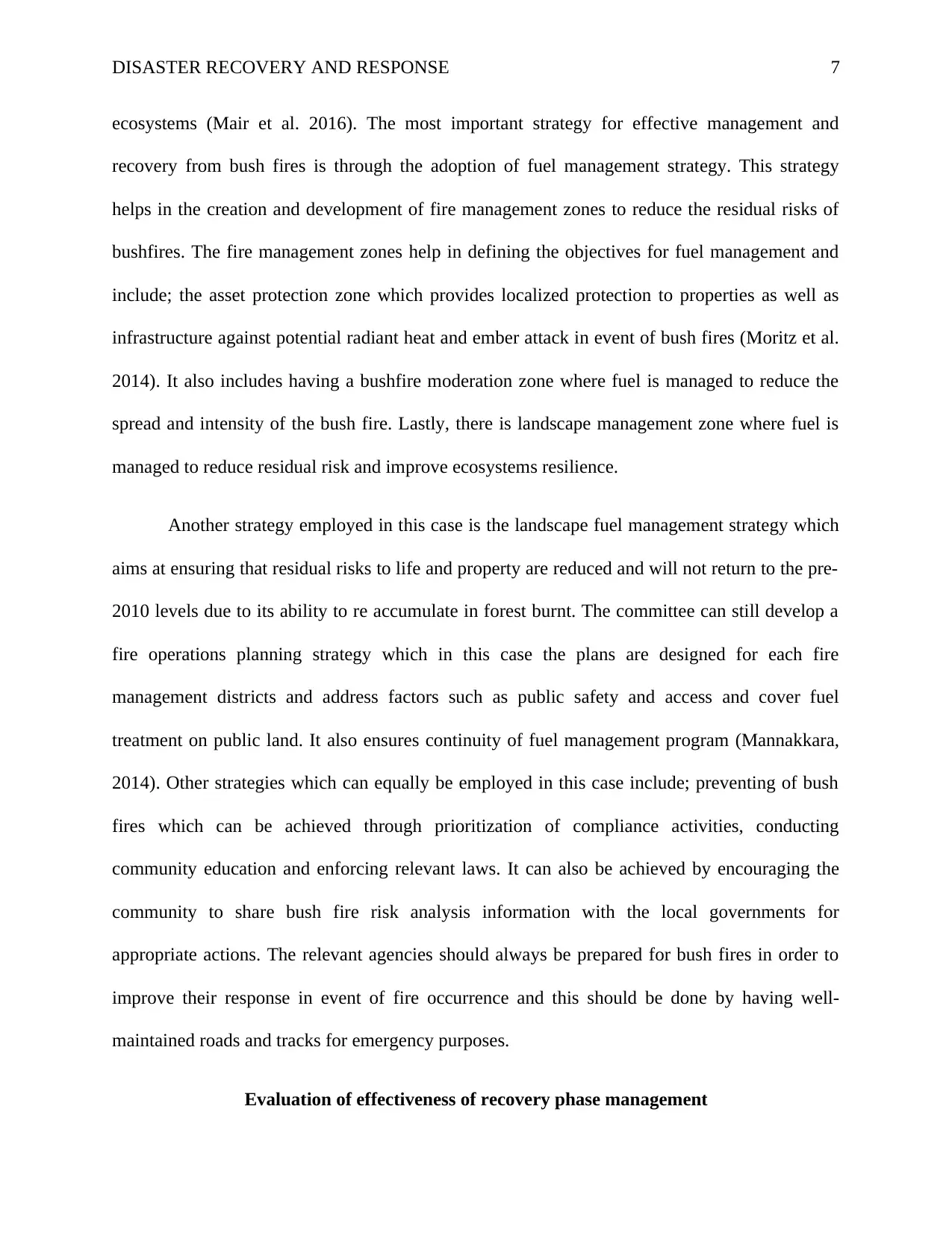
DISASTER RECOVERY AND RESPONSE 7
ecosystems (Mair et al. 2016). The most important strategy for effective management and
recovery from bush fires is through the adoption of fuel management strategy. This strategy
helps in the creation and development of fire management zones to reduce the residual risks of
bushfires. The fire management zones help in defining the objectives for fuel management and
include; the asset protection zone which provides localized protection to properties as well as
infrastructure against potential radiant heat and ember attack in event of bush fires (Moritz et al.
2014). It also includes having a bushfire moderation zone where fuel is managed to reduce the
spread and intensity of the bush fire. Lastly, there is landscape management zone where fuel is
managed to reduce residual risk and improve ecosystems resilience.
Another strategy employed in this case is the landscape fuel management strategy which
aims at ensuring that residual risks to life and property are reduced and will not return to the pre-
2010 levels due to its ability to re accumulate in forest burnt. The committee can still develop a
fire operations planning strategy which in this case the plans are designed for each fire
management districts and address factors such as public safety and access and cover fuel
treatment on public land. It also ensures continuity of fuel management program (Mannakkara,
2014). Other strategies which can equally be employed in this case include; preventing of bush
fires which can be achieved through prioritization of compliance activities, conducting
community education and enforcing relevant laws. It can also be achieved by encouraging the
community to share bush fire risk analysis information with the local governments for
appropriate actions. The relevant agencies should always be prepared for bush fires in order to
improve their response in event of fire occurrence and this should be done by having well-
maintained roads and tracks for emergency purposes.
Evaluation of effectiveness of recovery phase management
ecosystems (Mair et al. 2016). The most important strategy for effective management and
recovery from bush fires is through the adoption of fuel management strategy. This strategy
helps in the creation and development of fire management zones to reduce the residual risks of
bushfires. The fire management zones help in defining the objectives for fuel management and
include; the asset protection zone which provides localized protection to properties as well as
infrastructure against potential radiant heat and ember attack in event of bush fires (Moritz et al.
2014). It also includes having a bushfire moderation zone where fuel is managed to reduce the
spread and intensity of the bush fire. Lastly, there is landscape management zone where fuel is
managed to reduce residual risk and improve ecosystems resilience.
Another strategy employed in this case is the landscape fuel management strategy which
aims at ensuring that residual risks to life and property are reduced and will not return to the pre-
2010 levels due to its ability to re accumulate in forest burnt. The committee can still develop a
fire operations planning strategy which in this case the plans are designed for each fire
management districts and address factors such as public safety and access and cover fuel
treatment on public land. It also ensures continuity of fuel management program (Mannakkara,
2014). Other strategies which can equally be employed in this case include; preventing of bush
fires which can be achieved through prioritization of compliance activities, conducting
community education and enforcing relevant laws. It can also be achieved by encouraging the
community to share bush fire risk analysis information with the local governments for
appropriate actions. The relevant agencies should always be prepared for bush fires in order to
improve their response in event of fire occurrence and this should be done by having well-
maintained roads and tracks for emergency purposes.
Evaluation of effectiveness of recovery phase management
Paraphrase This Document
Need a fresh take? Get an instant paraphrase of this document with our AI Paraphraser
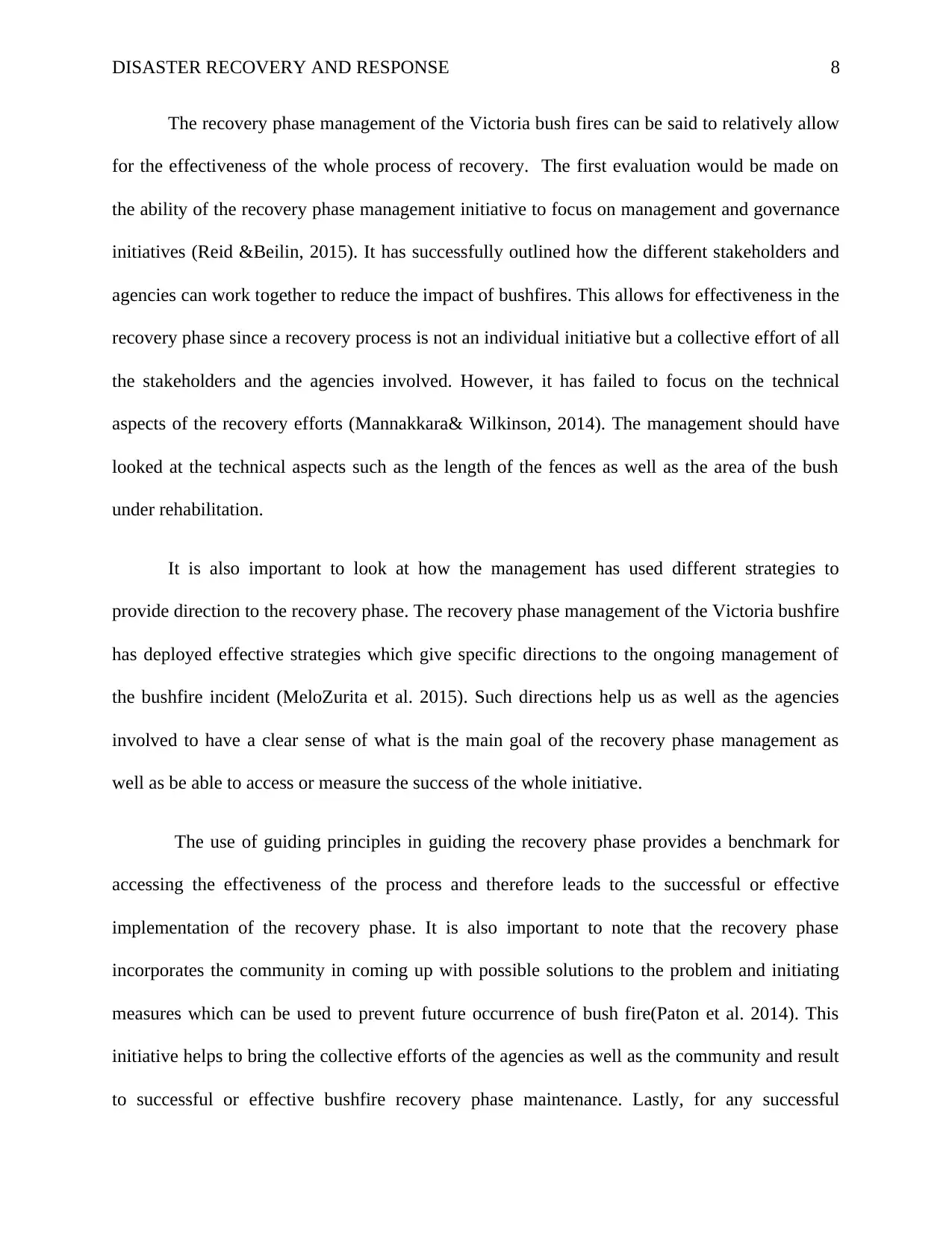
DISASTER RECOVERY AND RESPONSE 8
The recovery phase management of the Victoria bush fires can be said to relatively allow
for the effectiveness of the whole process of recovery. The first evaluation would be made on
the ability of the recovery phase management initiative to focus on management and governance
initiatives (Reid &Beilin, 2015). It has successfully outlined how the different stakeholders and
agencies can work together to reduce the impact of bushfires. This allows for effectiveness in the
recovery phase since a recovery process is not an individual initiative but a collective effort of all
the stakeholders and the agencies involved. However, it has failed to focus on the technical
aspects of the recovery efforts (Mannakkara& Wilkinson, 2014). The management should have
looked at the technical aspects such as the length of the fences as well as the area of the bush
under rehabilitation.
It is also important to look at how the management has used different strategies to
provide direction to the recovery phase. The recovery phase management of the Victoria bushfire
has deployed effective strategies which give specific directions to the ongoing management of
the bushfire incident (MeloZurita et al. 2015). Such directions help us as well as the agencies
involved to have a clear sense of what is the main goal of the recovery phase management as
well as be able to access or measure the success of the whole initiative.
The use of guiding principles in guiding the recovery phase provides a benchmark for
accessing the effectiveness of the process and therefore leads to the successful or effective
implementation of the recovery phase. It is also important to note that the recovery phase
incorporates the community in coming up with possible solutions to the problem and initiating
measures which can be used to prevent future occurrence of bush fire(Paton et al. 2014). This
initiative helps to bring the collective efforts of the agencies as well as the community and result
to successful or effective bushfire recovery phase maintenance. Lastly, for any successful
The recovery phase management of the Victoria bush fires can be said to relatively allow
for the effectiveness of the whole process of recovery. The first evaluation would be made on
the ability of the recovery phase management initiative to focus on management and governance
initiatives (Reid &Beilin, 2015). It has successfully outlined how the different stakeholders and
agencies can work together to reduce the impact of bushfires. This allows for effectiveness in the
recovery phase since a recovery process is not an individual initiative but a collective effort of all
the stakeholders and the agencies involved. However, it has failed to focus on the technical
aspects of the recovery efforts (Mannakkara& Wilkinson, 2014). The management should have
looked at the technical aspects such as the length of the fences as well as the area of the bush
under rehabilitation.
It is also important to look at how the management has used different strategies to
provide direction to the recovery phase. The recovery phase management of the Victoria bushfire
has deployed effective strategies which give specific directions to the ongoing management of
the bushfire incident (MeloZurita et al. 2015). Such directions help us as well as the agencies
involved to have a clear sense of what is the main goal of the recovery phase management as
well as be able to access or measure the success of the whole initiative.
The use of guiding principles in guiding the recovery phase provides a benchmark for
accessing the effectiveness of the process and therefore leads to the successful or effective
implementation of the recovery phase. It is also important to note that the recovery phase
incorporates the community in coming up with possible solutions to the problem and initiating
measures which can be used to prevent future occurrence of bush fire(Paton et al. 2014). This
initiative helps to bring the collective efforts of the agencies as well as the community and result
to successful or effective bushfire recovery phase maintenance. Lastly, for any successful
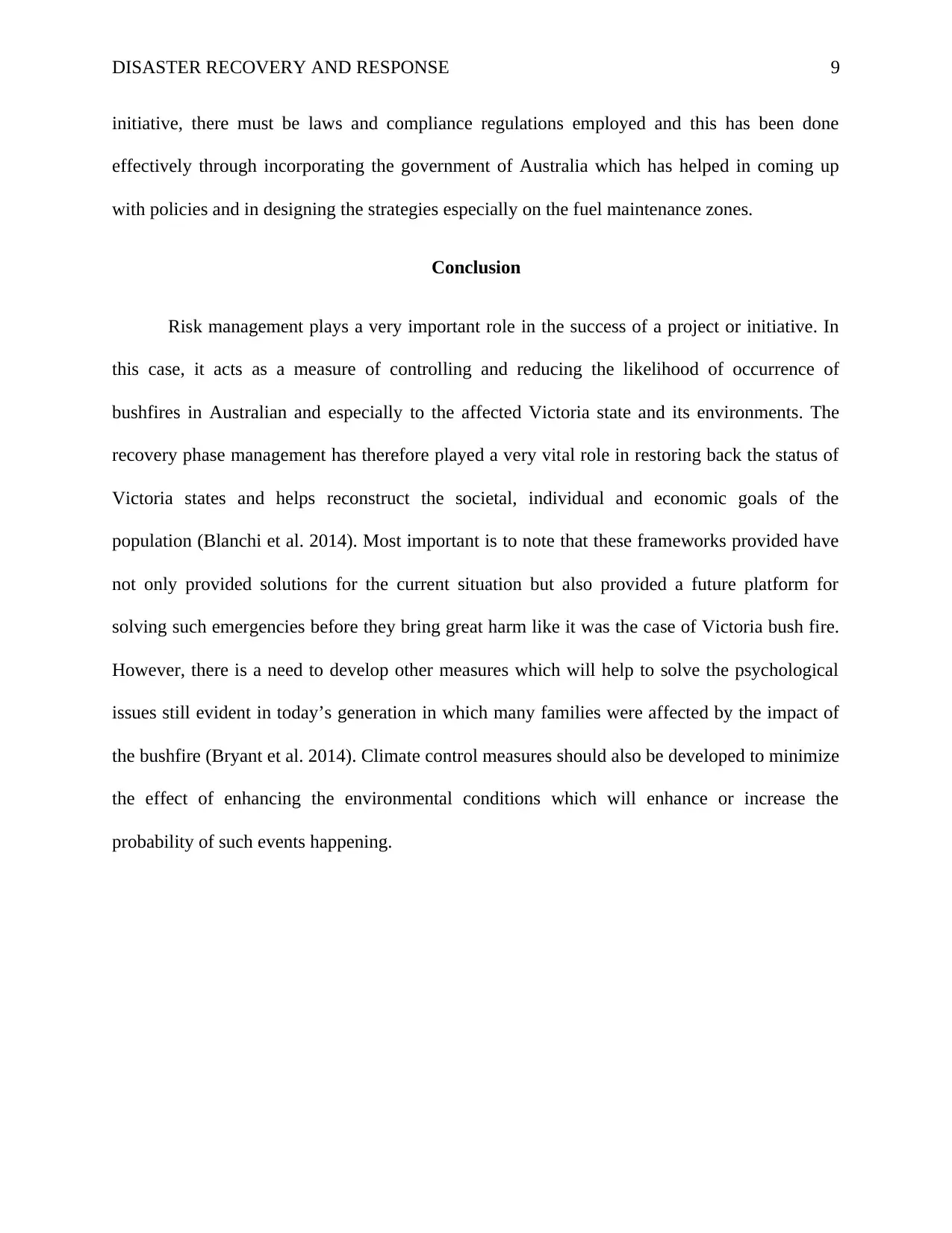
DISASTER RECOVERY AND RESPONSE 9
initiative, there must be laws and compliance regulations employed and this has been done
effectively through incorporating the government of Australia which has helped in coming up
with policies and in designing the strategies especially on the fuel maintenance zones.
Conclusion
Risk management plays a very important role in the success of a project or initiative. In
this case, it acts as a measure of controlling and reducing the likelihood of occurrence of
bushfires in Australian and especially to the affected Victoria state and its environments. The
recovery phase management has therefore played a very vital role in restoring back the status of
Victoria states and helps reconstruct the societal, individual and economic goals of the
population (Blanchi et al. 2014). Most important is to note that these frameworks provided have
not only provided solutions for the current situation but also provided a future platform for
solving such emergencies before they bring great harm like it was the case of Victoria bush fire.
However, there is a need to develop other measures which will help to solve the psychological
issues still evident in today’s generation in which many families were affected by the impact of
the bushfire (Bryant et al. 2014). Climate control measures should also be developed to minimize
the effect of enhancing the environmental conditions which will enhance or increase the
probability of such events happening.
initiative, there must be laws and compliance regulations employed and this has been done
effectively through incorporating the government of Australia which has helped in coming up
with policies and in designing the strategies especially on the fuel maintenance zones.
Conclusion
Risk management plays a very important role in the success of a project or initiative. In
this case, it acts as a measure of controlling and reducing the likelihood of occurrence of
bushfires in Australian and especially to the affected Victoria state and its environments. The
recovery phase management has therefore played a very vital role in restoring back the status of
Victoria states and helps reconstruct the societal, individual and economic goals of the
population (Blanchi et al. 2014). Most important is to note that these frameworks provided have
not only provided solutions for the current situation but also provided a future platform for
solving such emergencies before they bring great harm like it was the case of Victoria bush fire.
However, there is a need to develop other measures which will help to solve the psychological
issues still evident in today’s generation in which many families were affected by the impact of
the bushfire (Bryant et al. 2014). Climate control measures should also be developed to minimize
the effect of enhancing the environmental conditions which will enhance or increase the
probability of such events happening.
⊘ This is a preview!⊘
Do you want full access?
Subscribe today to unlock all pages.

Trusted by 1+ million students worldwide
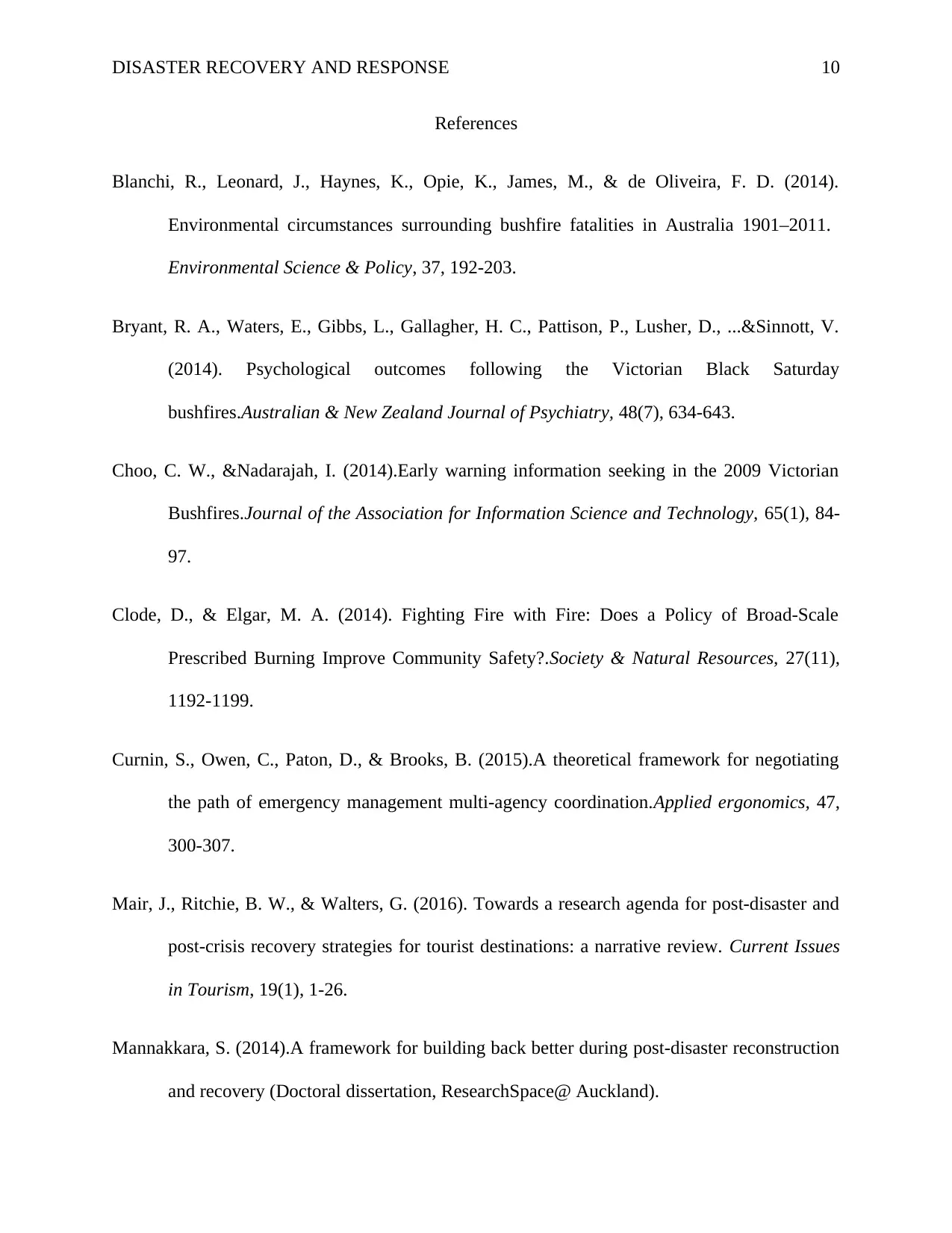
DISASTER RECOVERY AND RESPONSE 10
References
Blanchi, R., Leonard, J., Haynes, K., Opie, K., James, M., & de Oliveira, F. D. (2014).
Environmental circumstances surrounding bushfire fatalities in Australia 1901–2011.
Environmental Science & Policy, 37, 192-203.
Bryant, R. A., Waters, E., Gibbs, L., Gallagher, H. C., Pattison, P., Lusher, D., ...&Sinnott, V.
(2014). Psychological outcomes following the Victorian Black Saturday
bushfires.Australian & New Zealand Journal of Psychiatry, 48(7), 634-643.
Choo, C. W., &Nadarajah, I. (2014).Early warning information seeking in the 2009 Victorian
Bushfires.Journal of the Association for Information Science and Technology, 65(1), 84-
97.
Clode, D., & Elgar, M. A. (2014). Fighting Fire with Fire: Does a Policy of Broad-Scale
Prescribed Burning Improve Community Safety?.Society & Natural Resources, 27(11),
1192-1199.
Curnin, S., Owen, C., Paton, D., & Brooks, B. (2015).A theoretical framework for negotiating
the path of emergency management multi-agency coordination.Applied ergonomics, 47,
300-307.
Mair, J., Ritchie, B. W., & Walters, G. (2016). Towards a research agenda for post-disaster and
post-crisis recovery strategies for tourist destinations: a narrative review. Current Issues
in Tourism, 19(1), 1-26.
Mannakkara, S. (2014).A framework for building back better during post-disaster reconstruction
and recovery (Doctoral dissertation, ResearchSpace@ Auckland).
References
Blanchi, R., Leonard, J., Haynes, K., Opie, K., James, M., & de Oliveira, F. D. (2014).
Environmental circumstances surrounding bushfire fatalities in Australia 1901–2011.
Environmental Science & Policy, 37, 192-203.
Bryant, R. A., Waters, E., Gibbs, L., Gallagher, H. C., Pattison, P., Lusher, D., ...&Sinnott, V.
(2014). Psychological outcomes following the Victorian Black Saturday
bushfires.Australian & New Zealand Journal of Psychiatry, 48(7), 634-643.
Choo, C. W., &Nadarajah, I. (2014).Early warning information seeking in the 2009 Victorian
Bushfires.Journal of the Association for Information Science and Technology, 65(1), 84-
97.
Clode, D., & Elgar, M. A. (2014). Fighting Fire with Fire: Does a Policy of Broad-Scale
Prescribed Burning Improve Community Safety?.Society & Natural Resources, 27(11),
1192-1199.
Curnin, S., Owen, C., Paton, D., & Brooks, B. (2015).A theoretical framework for negotiating
the path of emergency management multi-agency coordination.Applied ergonomics, 47,
300-307.
Mair, J., Ritchie, B. W., & Walters, G. (2016). Towards a research agenda for post-disaster and
post-crisis recovery strategies for tourist destinations: a narrative review. Current Issues
in Tourism, 19(1), 1-26.
Mannakkara, S. (2014).A framework for building back better during post-disaster reconstruction
and recovery (Doctoral dissertation, ResearchSpace@ Auckland).
Paraphrase This Document
Need a fresh take? Get an instant paraphrase of this document with our AI Paraphraser
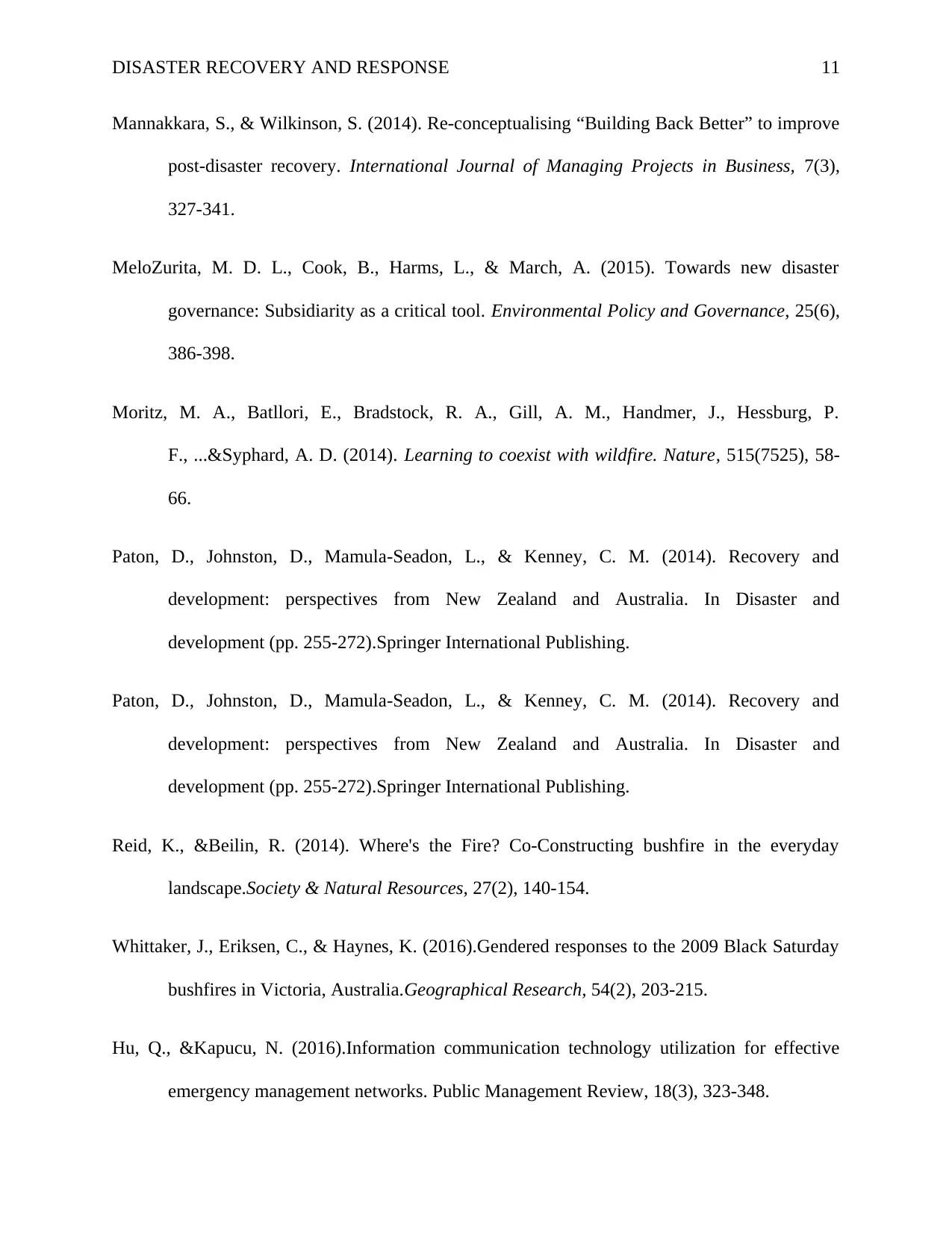
DISASTER RECOVERY AND RESPONSE 11
Mannakkara, S., & Wilkinson, S. (2014). Re-conceptualising “Building Back Better” to improve
post-disaster recovery. International Journal of Managing Projects in Business, 7(3),
327-341.
MeloZurita, M. D. L., Cook, B., Harms, L., & March, A. (2015). Towards new disaster
governance: Subsidiarity as a critical tool. Environmental Policy and Governance, 25(6),
386-398.
Moritz, M. A., Batllori, E., Bradstock, R. A., Gill, A. M., Handmer, J., Hessburg, P.
F., ...&Syphard, A. D. (2014). Learning to coexist with wildfire. Nature, 515(7525), 58-
66.
Paton, D., Johnston, D., Mamula-Seadon, L., & Kenney, C. M. (2014). Recovery and
development: perspectives from New Zealand and Australia. In Disaster and
development (pp. 255-272).Springer International Publishing.
Paton, D., Johnston, D., Mamula-Seadon, L., & Kenney, C. M. (2014). Recovery and
development: perspectives from New Zealand and Australia. In Disaster and
development (pp. 255-272).Springer International Publishing.
Reid, K., &Beilin, R. (2014). Where's the Fire? Co-Constructing bushfire in the everyday
landscape.Society & Natural Resources, 27(2), 140-154.
Whittaker, J., Eriksen, C., & Haynes, K. (2016).Gendered responses to the 2009 Black Saturday
bushfires in Victoria, Australia.Geographical Research, 54(2), 203-215.
Hu, Q., &Kapucu, N. (2016).Information communication technology utilization for effective
emergency management networks. Public Management Review, 18(3), 323-348.
Mannakkara, S., & Wilkinson, S. (2014). Re-conceptualising “Building Back Better” to improve
post-disaster recovery. International Journal of Managing Projects in Business, 7(3),
327-341.
MeloZurita, M. D. L., Cook, B., Harms, L., & March, A. (2015). Towards new disaster
governance: Subsidiarity as a critical tool. Environmental Policy and Governance, 25(6),
386-398.
Moritz, M. A., Batllori, E., Bradstock, R. A., Gill, A. M., Handmer, J., Hessburg, P.
F., ...&Syphard, A. D. (2014). Learning to coexist with wildfire. Nature, 515(7525), 58-
66.
Paton, D., Johnston, D., Mamula-Seadon, L., & Kenney, C. M. (2014). Recovery and
development: perspectives from New Zealand and Australia. In Disaster and
development (pp. 255-272).Springer International Publishing.
Paton, D., Johnston, D., Mamula-Seadon, L., & Kenney, C. M. (2014). Recovery and
development: perspectives from New Zealand and Australia. In Disaster and
development (pp. 255-272).Springer International Publishing.
Reid, K., &Beilin, R. (2014). Where's the Fire? Co-Constructing bushfire in the everyday
landscape.Society & Natural Resources, 27(2), 140-154.
Whittaker, J., Eriksen, C., & Haynes, K. (2016).Gendered responses to the 2009 Black Saturday
bushfires in Victoria, Australia.Geographical Research, 54(2), 203-215.
Hu, Q., &Kapucu, N. (2016).Information communication technology utilization for effective
emergency management networks. Public Management Review, 18(3), 323-348.
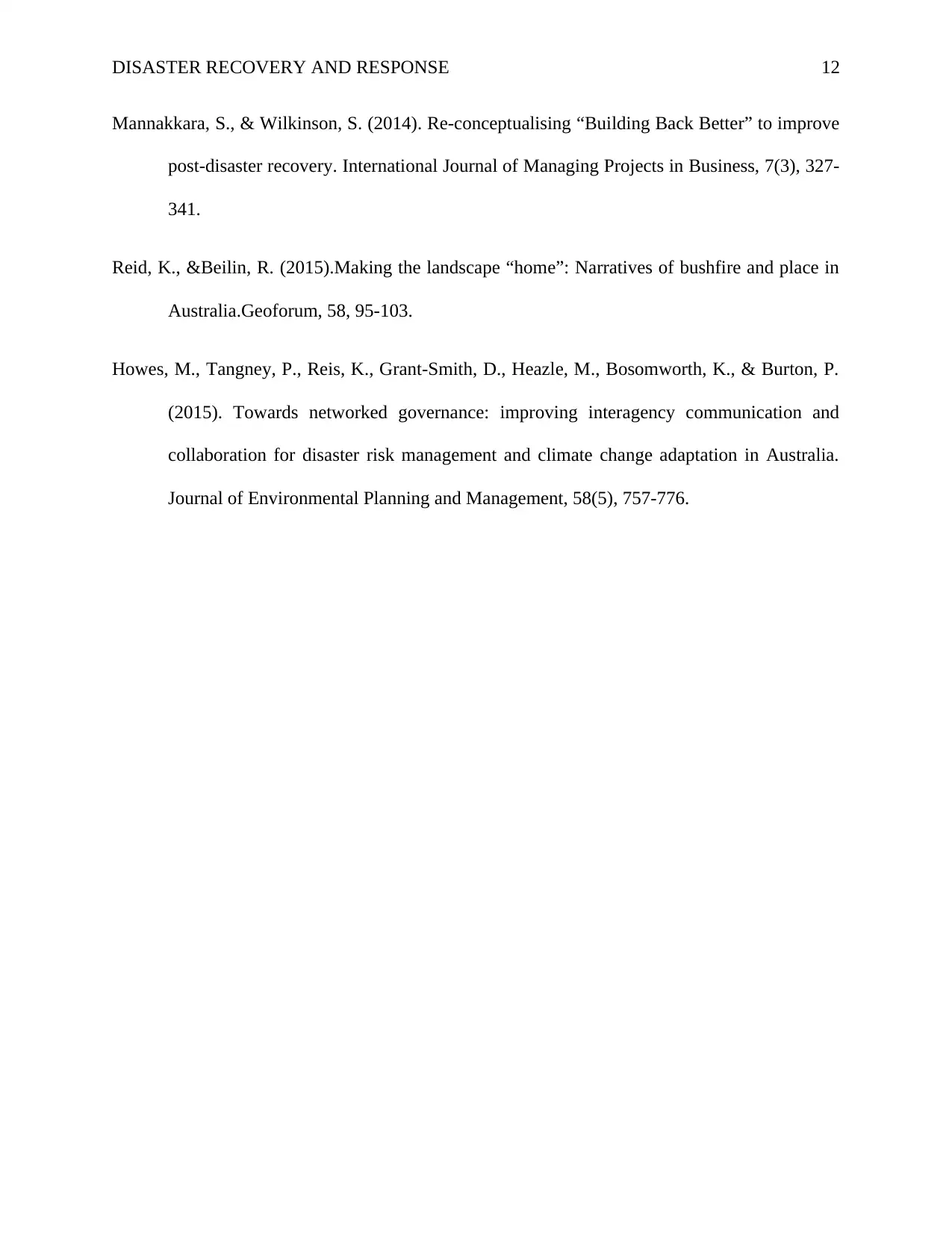
DISASTER RECOVERY AND RESPONSE 12
Mannakkara, S., & Wilkinson, S. (2014). Re-conceptualising “Building Back Better” to improve
post-disaster recovery. International Journal of Managing Projects in Business, 7(3), 327-
341.
Reid, K., &Beilin, R. (2015).Making the landscape “home”: Narratives of bushfire and place in
Australia.Geoforum, 58, 95-103.
Howes, M., Tangney, P., Reis, K., Grant-Smith, D., Heazle, M., Bosomworth, K., & Burton, P.
(2015). Towards networked governance: improving interagency communication and
collaboration for disaster risk management and climate change adaptation in Australia.
Journal of Environmental Planning and Management, 58(5), 757-776.
Mannakkara, S., & Wilkinson, S. (2014). Re-conceptualising “Building Back Better” to improve
post-disaster recovery. International Journal of Managing Projects in Business, 7(3), 327-
341.
Reid, K., &Beilin, R. (2015).Making the landscape “home”: Narratives of bushfire and place in
Australia.Geoforum, 58, 95-103.
Howes, M., Tangney, P., Reis, K., Grant-Smith, D., Heazle, M., Bosomworth, K., & Burton, P.
(2015). Towards networked governance: improving interagency communication and
collaboration for disaster risk management and climate change adaptation in Australia.
Journal of Environmental Planning and Management, 58(5), 757-776.
⊘ This is a preview!⊘
Do you want full access?
Subscribe today to unlock all pages.

Trusted by 1+ million students worldwide
1 out of 13
Related Documents
Your All-in-One AI-Powered Toolkit for Academic Success.
+13062052269
info@desklib.com
Available 24*7 on WhatsApp / Email
![[object Object]](/_next/static/media/star-bottom.7253800d.svg)
Unlock your academic potential
Copyright © 2020–2025 A2Z Services. All Rights Reserved. Developed and managed by ZUCOL.





